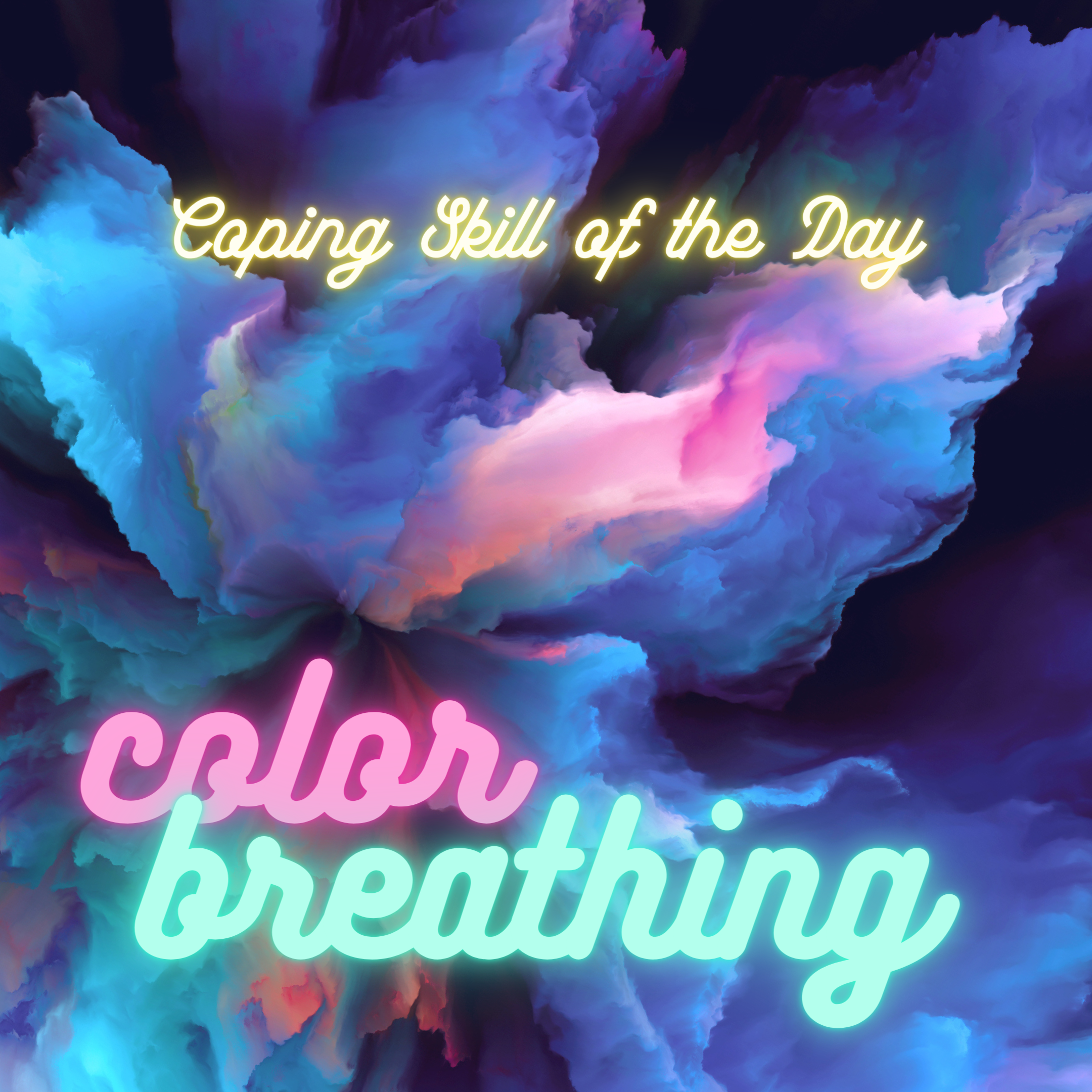What is color breathing?
Color breathing is a coping skill that combines a little mental imagery with intentional breathing to help modulate intense feelings, stabilize panic, soothe pain, slow rapid thoughts, or even get you more grounded. It's an invaluable tool that truly everyone can use, but it's especially beneficial for those who struggle with emotion dysregulation, flashbacks, dissociation, and more. So, how do you do it?!
There are many ways to use color breathing, so not only is customization the fun part but it's also the key to its success! One of the most common ways folks practice it is to first imagine a very calming color (perhaps cooling deep blues or purples, or warming yellows and golds for others). Then assign a color that matches the upsetting or painful emotions/sensations you're experiencing - perhaps reds, oranges, or blacks.
Slowly inhale the calming shade deep into your lungs. Watch it effortlessly locate all the areas of unrest, anxiety, or pain inside of you. See it just as easily envelope them, soothe them, heal them. As the color you see representing your distress gets extracted from every cell, space that it invaded, or place it radiated off of you, begin your exhale. Watch that color, in all of its shapes and textures, leave you through as long a breath as you can manage. It may leave in a rush, like it was almost expelled from your chest, or instead find itself slow and difficult to release as you contend with its resistance.
Repeat this deep inhaling and exhaling of colors until you feel more at ease. You may even find that the colors change a bit as you start to improve - with reds dialing back to oranges then yellows, its jagged edges softening. Or instead see black tarry sludge becoming thinner, lighter, and easier to lift out. This version is most commonly used for anxiety, panic attacks, anger or budding rage, and physical pain. But, some find it helpful for all overwhelming (or dysregulated) emotions - like grief, sadness, embarrassment, shame, or even apathy and numbness - similarly opting to inhale invigorating, light colors and exhale the weighted colors of misery, loneliness, or guilt.
Another method is to concentrate mostly on the exhale—inhaling any clear, healing breath, and with each exhale of the negative feelings, watch the colors change like a gradient. Shifting from bright fiery shades to cooler tones, or from dark, fully-opaque colors to light, whimsy translucence. This is particularly useful if you haven't been able to identify which feelings you're experiencing or have no idea "what you need" to make things better. You just know that what you're dealing with is intense and you want it out of you. Quickly. So, instead, put all your energy into exhaling any highly active colors until you either get to the calmer end of the 'rainbow'. Maybe can’t even see your breath at all. This can be a really effective way to still dial things down. (You can also dial up, and use quicker breaths, if you need the reverse to combat numbness!)
There are many, many other ways to customize this tool to work best for you. The more you can truly visualize the practice and believe in its effectiveness, the more successful it will be - physiologically! There are also countless ways to apply this template beyond colors alone. Incorporate speeds for racing thoughts or your pounding heart rate that needs stilled and quieted. Bring in different textures, medicinal properties, magic or fantasy elements, sounds, or physical gestures to go along with the flow of your breath. Fully connect with your body and be active in shifting what it is experiencing. Help yourself feel more in control—owning your emotions, your body, and your healing.
For those who are not naturally inclined toward creative imagery, have aphantasia, or don't yet know what to assign their internal experiences, holding physical objects - like color wheels/dials you've made for yourself or colorful photos you like or have on your phone - can be helpful. You can use them as both a visual reference as well as a tool you can manually change - matching it to the color you either just achieved, are aiming to get to next, or need to pull from in your current inhale. These are great ways to make this technique more accessible to you. Modify it to be exactly what you benefit from most!
How would you go about color breathing?
Sharing new ideas, suggestions, or personal experiences - especially from other survivors -
can often be just the thing that makes new techniques click for someone else!
Happy, easier breathing!
MORE POSTS YOU MAY FIND HELPFUL:
✧ Grounding 101: 101 Grounding Techniques
✧ Distraction 101: 101 Distraction Tools
✧ Flashbacks 101: 4 Tools to Cope with Flashbacks
✧ Self-Care 101: 101 Self-Care Tools
✧ Nighttime 101 and Nighttime 201: Sleep Strategies for Complex PTSD
✧ Color Breathing 101: How to Calm Overwhelming Emotions and Physical Pain
✧ Imagery 101: Healing Pool and Healing Light
✧ DID Myths: Dispelling Common Misconceptions about Dissociative Identity Disorder
✧ Did You Know?: 8 Things We Should All Know about C-PTSD and DID
✧ Trauma and Attachment: 3-Part Series on Attachment Theory with Jade Miller
❖ Article Index ❖




